Samsung Series 7 Ultra Touch 740u3e
Review Samsung ATIV Book 7 740U3E-A01UB Ultrabook
A volume for the road. Samsung's 13.three-inch Ultrabook features a 3rd-generation i5 CPU with integrated graphics, a 128 GB SSD, and a Full-Hd touchscreen. How well the sleek-looking Ultrabook with previous-generation hardware compares to its competition is the subject of our review.
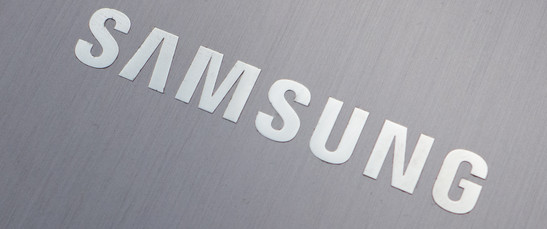
The Ativ Book 7 Ultrabook is part of Samsung's "Premium Series" and every bit such sits but one tier beneath the manufacturer'due south top-cease, ultra-slim, and rather pricey Ativ Book ix models. Considering the somewhat outdated processor and the fact that a dedicated graphics bill of fare is - at to the lowest degree in the US - not an option, the 13.3-inch notebook is by no means inexpensive with a price signal above $1000. The hardware, consisting of an Intel Core i5-3337U with the integrated HD 4000 GPU, 4 GB of single-aqueduct RAM, and a 128 GB mSATA SSD, is not cutting border, only should still guarantee adequate performance.
Regular readers of our reviews know that Samsung renamed their Serial-notebooks to "Ativ" earlier this year. Our European colleagues already took a look at the Samsung Series 7 Ultra Touch 740U3E-S02DE Ultrabook, which ships with a more powerful Intel Core i7-3537U and a defended AMD Radeon HD 8570M.
The category of Ultrabooks featuring a smaller form cistron is hotly contested, as most manufactures have at to the lowest degree one, if non several like-sized models in their portfolio. At the beginning of the year, we reviewed the Asus Zenbook Prime UX31A Touch, which also comes with a faster (at that time latest-generation) Ivy Bridge Intel Cadre i7-3517U and a Total-Hd brandish panel. The fairly recently released premium Zenbook UX301LA ups the dues with a Haswell Core i7-4558U, Iris Graphics 5100, and an even higher resolution of 2560x1440 pixels. Of course, there are significantly less expensive options like Lenovo's IdeaPad U330p and U310 Touch, which come with a much lower resolution of 1366x768 pixels instead.
Let's see how our review model compares to the similarly-sized competing Ultrabooks.
The chassis clearly borrows pattern cues from other models in the series and looks very like to the larger 14-inch Ativ Book 5 Touch and the 15.6-inch Ativ Book 6 Touch. To reflect its more than premium condition, Samsung uses brushed aluminum throughout instead of a combination of metallic and fiber glass.
The aluminum construction looks fashionable and the build quality is very practiced with tight tolerances and even, barely noticeable gaps. The chassis and the lid are torsionally reasonably rigid, although the keyboard deck flexes a little flake too much for our liking when pressure is applied, especially in the middle towards the back. While the hinges on the bigger siblings allow the displays to tilt all the way dorsum, the maximum opening angle of the Book 7 is virtually 135 degrees, which sometimes isn't sufficient to view the screen head-on when the Ultrabook is used on the lap. The single swivel is stiff enough to hold the display deeply and without noticeable wobbles.
At 324 x 224 10 18.8 mm, our review model is almost identical in footprint and thickness to the Asus Zenbook Prime number UX31A Touch, merely with a weight of 1.58 kg, the Book seven is on the heavier side. The UX31A weighs 1.47 kg and also comes with a lighter power adapter (185 vs. 260 grams). The IdeaPad U330p is likewise marginally lighter, despite its heavier platter-based hard drive. Still, the Ativ Book 7 740U3E-A01UB is easy to carry and to slip into a handbag.
Ultrabooks are not known for a plethora of connectivity options, although the Book 7 does ameliorate than most here: it at least offers a total-sized HDMI port aslope the mini-VGA port, which requires a special, optional adapter dongle. Simply i USB three.0 port is included, the other ii are USB 2.0. Just like on the 14-inch Ativ Book 5, all major ports are located behind the mid-line and cables or USB devices don't oversupply the work infinite or interfere with performance of an external mouse. The ane exception to the in a higher place is the SD card slot with its somewhat annoying plastic cover, which doesn't fold down, but rather needs to be rotated out of the fashion.
Advice
A Gigabit Ethernet controller from Realtek (RTL8168/8111) ensures decent cabled speeds, while an Intel Centrino Advanced-N 6235 adapter takes care of wireless connectivity via both the 2.4 GHz and 5 GHz bands. The dual-stream (2x2) module supports Wi-Fi standards 802.xi a/b/thou/north with a maximum theoretical throughput of 300 Mbit/southward, every bit well as Bluetooth iv.0 and Wireless Display (WiDi). During our time with the notebook, we never had any issues with reception quality or dropped connections.
Accessories
The shipping carton includes no accessories across the standard quick start guide, warranty data, the Windows eight Basics guide, and the Air conditioning adapter. Optional accessories include the aforementioned VGA adapter dongle, a Slim External DVD Bulldoze, likewise as a carrying pouch.
Warranty
In the US, the Ativ Book 7 Ultrabook is covered with a very basic 12 month standard parts and labor warranty.
Keyboard
While the entire deck is made from aluminum, the chiclet-way keyboard has to brand practice with silver plastic keys, which diminishes the premium appearance of the Ultrabook somewhat. The layout is very good and the keys are adequately sized at 15 x 15 mm, merely feedback is spongy and the tactile feel very express due to the extremely short travel of roughly 1.ii mm. Yet, we were able to affect type with surprising accuracy. Every bit expected, the keyboard is backlit and offers iv effulgence levels. One effect: with the backlight activated in moderately bright environments, the lettering on the keys blends in and it tin can be very hard to identify the keys.
Touchpad
The touchpad comes once again from manufacturer Elan and measures 102 x 68 mm. The clickpad, which features no dedicated left and right mouse buttons just a clickable surface area instead, is recessed slightly and supports multi-impact as well as Windows 8 swipe gestures. A very extensive command panel allows the touchpad gestures and behavior to exist adjusted and fine-tuned. The click feedback is very adept, fingers glide hands beyond the smooth surface, and general navigation, besides as two-finger scrolls and compression-to-zoom worked well. Unfortunately, we had some of the same issues we experienced while reviewing the he Ativ Book 6 and ended upwardly having to reboot the Ultrabook on a couple of occasions to stop erratic cursor movements. We hope that Samsung addresses this issue with a driver update.
Touchscreen
Equally per Intel'southward revised Ultrabook-standards, the Ativ Book 7 is touchscreen enabled. The capacitive panel recognizes upwardly to x fingers simultaneously and responds quickly and accurately. The thin rubber bumper protecting the display from touching the keyboard when the chapeau is closed, does go a niggling in the way of edge swipes, withal.
The Total-Hard disk drive 1920 ten 1080 pixel touchscreen panel is supplied by Chi Mei. Samsung does not specify whether or not this is an IPS display, but the console type CMN1343 (N133HSE-EA1) is also used in other models like the Asus Zenbook UX31A/UX32VD and listed every bit IPS in those cases. Samsung promises a brightness of 350 nits thanks to the "SuperBright Plus Technology", but our measurements can't confirm the claim: nosotros adamant a maximum of merely virtually 270 nits and an average of about 262 nits when we measured the brightness across ix quadrants using our tool X-Rite i1Basic Pro two. Although information technology stands to reason that the touchscreen layer on top of the panel decreases the effulgence somewhat, nosotros still find it a flake disappointing that Samsung's claim is and then inaccurate.
TheZenbook Prime UX31A Bear on accomplished an average brightness of just under 290 nits; budget panels usually average around 200 nits. The brandish Lenovo uses for theIdeaPad U330p is downright dismal at below 100 nits. Dell's XPS 12 convertible, which uses a 12.5-inch Full Hard disk IPS display, reaches a very good 340 nits average.
The effulgence distribution of 95 % is outstanding. The screen of the Ativ Volume vii maintains its maximum brightness even when running on battery power. The blackness value of 0.732 cd/m² and the contrast of 363:i are not that corking when compared to the UX31A Touch on, which managed 0.64 cd/m² and 523:ane, respectively. The Dell XPS 12 achieves a similar contrast of 412:1.
| 268.7 cd/m² | 264 cd/m² | 256.2 cd/one thousand² | ||
| 261.nine cd/m² | 265.8 cd/m² | 262.6 cd/m² | ||
| 254.9 cd/m² | 265.5 cd/m² | 256.six cd/m² | ||
Distribution of brightness
CMN1343 N133HSE-EA1
10-Rite i1Pro 2
Maximum: 268.7 cd/g² (Nits) Boilerplate: 261.8 cd/chiliad²
Brightness Distribution: 95 %
Heart on Battery: 265.8 cd/one thousand²
Contrast: 363:ane (Black: 0.732 cd/grand²)
ΔE Color 2.21 | 0.59-29.43 Ø5.three
ΔE Greyscale 1.28 | 0.64-98 Ø5.6
61.55% AdobeRGB 1998 (Argyll one.6.3 3D)
68.1% AdobeRGB 1998 (Argyll 2.2.0 3D)
92.7% sRGB (Argyll 2.2.0 3D)
74.5% Display P3 (Argyll ii.2.0 3D)
Gamma: 2.41
Color space reproduction covers near 83 pct of the sRGB spectrum and about 62 % of AdobeRGB. While certainly not good enough for professional graphics artist, the color space reproduction is much better than what budget screens are capable of and should be more than than sufficient for the average habitation user. The Dell XPS 12 simply reaches virtually 63 % of sRGB; the Zenbook Prime UX31A Bear on also has less coverage than our review model. The IdeaPad U330p over again underperforms significantly, as tin can be seen in the fourth screenshot below.
We go on our analysis of the review model's color reproduction using the CalMan 5 software. Just like the display of the recently reviewed 15.6-inch Ativ Book 6 Touch, the color accurateness is a clear cut above the rest: the average DeltaE-deviations for grayscale and colors are only one.28 and 2.21, respectively. We measured a maximum deviation of a little over 5 for the color orange. The color temperature of almost 6300K is actually slightly on the warm side, which is unusual for white-LED displays. The gamma value of 2.41 is likewise is very close to the ideal value of 2.2 (for sRGB). In this instance, calibration does non significantly improve the quality of the panel, which is good news since most of the displays in a abode-use scenario are going to remain uncalibrated. Overall, nosotros are very impressed with the color accurateness of this particular touchscreen panel.
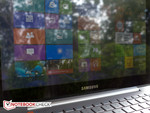
Although the average brandish effulgence of 260 cd/m² is sufficient for decent outdoor performance, it's even so appropriate to avoid direct sunlight if possible, since this is a highly reflective border-to-edge glass display and the screen content gets difficult to decipher. We had no problems working in the shade, only brightly lit environments are spring to cause some eyestrain in the long run.
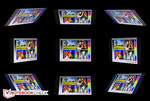
The display of the Ativ Book seven Ultrabook looks very good even when the user deviates very far from the ideal heart viewpoint. Dissimilarity and effulgence practise drib somewhat, but significant colour shifts or inversions exercise non occur even at extremely shallow angles. Viewing angle stability is much ameliorate than commonly seen with TN panels.
The Book 7 utilizes an Intel Ivy Bridge Core i5-3337U CPU. The dual-core processor features a nominal clock speed of 1.8 GHz and a is designed for low power consumption. The integrated Intel Hard disk drive 4000, which idles at 350 MHz and can overclock to 1100 MHz, is the sole source of graphics power. For additional data on the HD 4000 and how it compares, please cheque out our dedicated GPU page.
Samsung uses a 128 GB mSATA SSD from Liteon, which is connected to a SATA Three interface. RAM for our review model is provided by a unmarried-channel PC3-12800 DDR3 4 GB module. The RAM can be expanded, since i additional slot is open up, although doing and so requires the removal of the entire bottom plate of the system. After completing that task, the other components similar the fan, the PCI WLAN card, as well as the mSATA drive get accessible and tin can be replaced or expanded.
At the point of writing, Samsung does not offering other configurations of the Ativ Book vii Ultrabook.
System data Samsung 740U3E-A01UB
Processor
The Intel Core i5-3337U is a dual-core 22 nm Ivy Span CPU. The 1.viii GHz ULV processor with a TDP of 17 watts supports both Hyper Threading and Turbo Boost and tin overclock a single core to ii.vii GHz and both cores to two.5 GHz. Although Haswell-generation ULV processors would offer a boost in performance per MHz combined with additional ability savings, Samsung has not updated any of their Ativ Book notebooks except the high-end Volume 9 with the fourth-generation CPUs.
Non much needs to be said about the capabilities of this detail CPU, as information technology is used in many different subnotebooks and Ultrabooks and performs exactly like expected. The i5-3337U in our review model scored 4716 points running the single-core rendering portion of the Cinebench R10 (64 Bit) test, which is marginally faster than the 4609 points for the same CPU in Samsung'southward ownAtiv Book 5.
The 1.6 GHz Haswell Intel Core i5-4200U in the Dell XPS 12 scored 2.48 points during the multi-core Cinebench R11.5 (64 Bit) benchmark test, which is almost identical to the 2.49 points for the Ativ Book 7. The higher-end i.ix GHz Ivy Bridge Intel Core i7-3517U Asus uses in the Zenbook Prime number UX31A Touch concluded up with two.82 points, which is a plus of about 13 %.
Overall performance of the mid-range i5-3337U is sufficient for everyday tasks and we did non notice any CPU-related delays during the evaluation period. It's important to keep in mind though that this is a ULV processor designed primarily for low power consumption, then users interested in desktop-like performance need to await elsewhere. For more data virtually the CPU and various benchmarks please check our dedicated page.
Cinebench R10 Rendering Single 32Bit
3707
Cinebench R10 Rendering Multiple CPUs 32Bit
7699
Cinebench R10 Shading 32Bit
5224
Cinebench R10 Rendering Single CPUs 64Bit
4716 Points
Cinebench R10 Rendering Multiple CPUs 64Bit
9611 Points
Cinebench R10 Shading 64Bit
5207 Points
Cinebench R11.5 CPU Single 64Bit
1.11 Points
Cinebench R11.5 CPU Multi 64Bit
two.49 Points
Cinebench R11.v OpenGL 64Bit
13.13 fps
Help
Organisation Performance
We use PCMark 7 to evaluate overall system operation. Thank you to its fast mSATA SSD, the final score of 4617 points is a very good result. The Asus Zenbook Prime UX31A Ultrabook (non-touch) with the same CPU is faster even so and scored 5155 points (+ 12 %), while theZenbook Prime UX31A Affect falls way behind with3724 points due to a sub-par Entertainment score.
The advantages of SSDs are significant as far as the PCMark results are concerned: the LenovoIdeaPad U330p, which is equipped with a standard platter-based Seagate ST500LM000 5400 rpm hard drive, topped out at 3529 points (- 24 %).
Subjectively, performance is very snappy no affair what task is at hand and way ahead of ultraportables equipped with conventional hard drives. Boot times are quick (about ten seconds to the Windows 8 tile screen) and opening apps doesn't require a lot of patience.
iv.8
Windows 8 Experience Index
Processor
Calculations per second
half-dozen.9
Memory (RAM)
Memory operations per second
5.9
Graphics
Desktop performance for Windows Aero
4.eight
Gaming graphics
3D business and gaming graphics
6.two
Primary hard disk drive
Disk data transfer rate
8.1
| PCMark vii Score | 4617 points | |
| Assistance | ||
Mass storage
The 128 GB Liteon LMT-128M6M is a very good performer with average transfer rates of 269.5 MB/s and access times of 0.135 ms according to HD Tune. The larger 256 GB ADATA XM11 in the Zenbook Prime UX31A Touch is slower at 237.iii MB/s and 0.two ms, respectively. For some reason, the same LMT-128M6M in the Dell XPS 12 is significantly faster yet at 366.3 MB/s and 0.1 ms.
The CrystalDiskMark 4K tests, which are a adept indicator as far as bodily Windows and application operation is concerned, resulted in read and write speeds of 22 and 39.26 MB/southward, respectively. The 256 GB ADATA XM11 in the UX31A Touch is faster here at 24.39 and 46.three MB/s.
One caveat of this item storage solution: 128 GB is not a lot of storage infinite by today'southward standards. Because of the recovery partition and the pre-installed software, simply about 60 GB are available for the stop user to install programs.
For a more detailed assay of the SSD performance, please take a look at our hard bulldoze benchmark table.
Transfer Rate Minimum: 134.6 MB/s
Transfer Rate Maximum: 372.6 MB/s
Transfer Charge per unit Average: 269.5 MB/s
Sequential Read: 498.9 MB/s
Sequential Write: 319.2 MB/southward
4K QD32 Write: 218.9 MB/south
Sequential Read: 494.6MB/due south
Sequential Write: 235.2MB/south
Admission Time Read: 0.167ms
Access Time Write: 0.102ms
Gaming Performance
The operation of the integrated Hd 4000 offers no surprises, equally the GPU tin can only handle older and not very enervating games at decent frame rates. Current games need to be run at the lowest settings to be playable at all - and even then, stuttering will exist unavoidable at times. During our graphic-intensive examination with Furmark, the GPU frequency remained stable at chiliad MHz, so gaming is not going to exist hindered by lower-than-normal GPU functioning.
Games like Anno 2070 tin exist played with the settings set to low at merely under 30 fps. The Ativ Volume 5, which is equipped with the same processor and integrated GPU, managed a slightly higher 34 fps. For comparison: the Sony Vaio Duo thirteen SVD1321M2E, which uses a Haswell-integrated Intel HD Graphics 4400, allows for a substantially higher 70 fps.
The functioning of the GPU could probably exist improved with a 2d RAM module to allow the memory to operate in dual-aqueduct manner. For users not really interested in gaming, the performance of the HD 4000 should be sufficient.
| depression | med. | loftier | ultra | |
| Anno 2070 (2011) | 29 | eighteen.eight | 12.4 | 6.2 |
| Fifa 14 (2013) | 87.1 | 56.7 | 33.seven | eighteen |
| 3DMark 06 Standard Score | 4086 points | |
| 3DMark Vantage P Result | 2833 points | |
| 3DMark eleven Performance | 597 points | |
| 3DMark Ice Tempest Standard Score | 27823 points | |
| 3DMark Cloud Gate Standard Score | 3247 points | |
| 3DMark Fire Strike Score | 457 points | |
| Help | ||
Organisation Noise
During idle, nosotros recorded sound levels of simply under thirty dB, which ways that the Ultrabook is more or less inaudible. Typical tasks like give-and-take processing don't increment the noise much across 31 dB. Under medium load levels, we measured an average of nearly 35 dB, which is even so acceptable. During the stress test and hence maximum load, we recorded almost 45 dB, which can be annoying over prolonged periods of time. These noise levels are not going to occur under normal everyday use, even so.
Noise Level
| Idle | 29.nine / 30 / 31.4 dB(A) | |
| Load | 35 / 44.half-dozen dB(A) | |
 | ||
| 30 dB 40 dB(A) 50 dB(A) | ||
| min: | ||
Temperature
The Ultrabook stays reasonably absurd during idle: we measured a maximum of well-nigh 33 degrees C. The hotspot is in the middle towards the back adjacent to the swivel-based fan exhaust, and then this is not a business during use at all. The palm rest remains relatively absurd at only below xxx degrees C. The Zenbook Prime number UX31A Touch on doesn't get much warmer at 35 degrees C during idle. The areas effectually the touchpad but get about two degrees warmer with the Ativ Book vii subjected to our stress test, while the bottom dorsum of the notebook at present reaches up to 45 degrees. Like with the other Samsung notebooks we have recently reviewed, the hotspots are concentrated in the centre, so working with the Ultrabook on the lap is however possible without whatsoever major discomfort. The UX31A Affect tops out at over 50 degrees, which is already rather uncomfortable.
Please also note that our stress exam measurements are non indicative of the temperatures that will occur nether normal, everyday usage.
| |||||||||||||||||||||||||
| Maximum: 43.8 °C = 111 F Average: 34.viii °C = 95 F | |||||||||||||||||||||||||
| |||||||||||||||||||||||||
| Maximum: 45.4 °C = 114 F Average: 36.v °C = 98 F | |||||||||||||||||||||||||
Power Supply (max.) 52.two °C = 126 F | Room Temperature 24 °C = 75 F | Raytek Raynger ST
| |||||||||||||||||||||||||
| Maximum: 33 °C = 91 F Average: 30 °C = 86 F | |||||||||||||||||||||||||
| |||||||||||||||||||||||||
| Maximum: 32.half dozen °C = 91 F Boilerplate: 30.five °C = 87 F | |||||||||||||||||||||||||
Power Supply (max.) 52.two °C = 126 F | Room Temperature 24 °C = 75 F | Raytek Raynger ST
(±) The average temperature for the upper side nether maximal load is 34.8 °C / 95 F, compared to the average of 30.7 °C / 87 F for the devices in the course Subnotebook.
(±) The maximum temperature on the upper side is 43.viii °C / 111 F, compared to the average of 35.eight °C / 96 F, ranging from 21.4 to 58.four °C for the class Subnotebook.
(-) The bottom heats up to a maximum of 45.4 °C / 114 F, compared to the average of 39.v °C / 103 F
(+) In idle usage, the boilerplate temperature for the upper side is 30 °C / 86 F, compared to the device average of thirty.7 °C / 87 F.
(+) The palmrests and touchpad are reaching skin temperature every bit a maximum (32.ii °C / 90 F) and are therefore not hot.
(-) The average temperature of the palmrest area of similar devices was 28.four °C / 83.one F (-three.eight °C / -6.9 F).

To determine the ability of the test candidate to handle heavy workloads and to run across if throttling is an result, nosotros stress the CPU and GPU with Prime95 and Furmark while monitoring with the tools CPU-Z, GPU-Z and HWiNFO. With simply Prime95 active, both CPU cores operated at their maximum Turbo Boost frequency of 2.5 GHz. With only FurMark agile, the GPU was running at 1100/800 MHz (cadre/retention) earlier stabilizing quickly at aroundthou MHz.
Under maximum stress with both Prime95 and FurMark running in parallel for about 2 hours, the CPU was running at its nominal frequency of i.8 GHz, while the GPU maintained 850 MHz. This ways that Turbo Boost is non active on the CPU side nether full load atmospheric condition.
At the cease of the stress examination, the CPU and GPU both reached right around 81 degrees C, which is well within the acceptable range. When nosotros ran 3DMark 11 immediately afterward the exam, the score was inside a few points of the original run (597 pre, 599 post stress test). System operation is not reduced when running on battery ability, either - although care needs to be taken equally the power profile tin switch inadvertently.
Speakers
Considering this is an Ultrabook, the sound quality is impressive. The 2JBL stereo speakers (2W 10 2) sit on the bottom of the notebook and fire downwardly. While the highs, mids, and lows are well-balanced, the speakers starting time to sound distorted at higher book levels and bass is lacking a bit, as expected. Overall, the sound quality is certainly sufficient for videos and the occasional soundtrack, although external speakers or headphones are still recommended for those demanding the highest audio quality.
Battery Life
The Samsung Ativ Book 7 Ultrabook utilizes a rather large 57 Wh Li-polymer battery, which helps explain why the unit is heavier than competing models. The Zenbook Prime number UX31A Touch comes with a 50 Wh battery, the battery of the IdeaPad U330p has a much lower chapters of 45 Wh.
To assess the battery life under various weather, we utilise the tool Battery Eater Pro with the screen saver and timeouts disabled. To establish the maximum bombardment life, we turn the brightness all the mode downwardly, use the Ability Saver profile, disable wireless, then run the Reader'southward test. The Volume 7 lasted for nigh 10 hours and 30 minutes. The U31A Impact quit just shy of 9 hours.
For the significantly more relevant WLAN test, we set the contour to Balanced and the effulgence to 150 nits. A script then visits different websites every xl seconds to simulate typical browsing atmospheric condition. The review notebook shut down subsequently near 6 hours and thirty minutes. The Zenbook Prime UX31A Touch lasted 4 hours and 20 minutes, the IdeaPad U330p six hours and fifteen minutes. We should point out hither that this is not a really fair comparison, as the display of the latter model doesn't fifty-fifty come close to reaching the required brightness of 150 nits. The Dell XPS 12, which admittedly has a slightly smaller screen, lasted shut to 9 hours - a issue that tin be at least partially attributed to the new Haswell hardware.
To determine the minimum battery life, nosotros choose the High Operation profile, enable wireless, and set the display to maximum brightness. The Ultrabook shut down afterward about ii hours and twoscore minutes, which is a very good effect.
Battery Runtime
| Idle (without WLAN, min brightness) | 10h 24min | |
| WiFi Surfing | 6h 28min | |
| Load (maximum brightness) | 2h 37min |
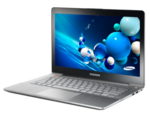
Samsung does many things right with the Ativ Book 7 Ultrabook. The stylish and sleek aluminum construction , high build quality, very bright ten-point multi-touch Full-Hard disk drive display with swell color accurateness, and long battery life all add up to a very usable and mobile travel companion. Boot times are also very quick and the overall performance is quite snappy. Nosotros as well love the fact that the RAM is expandable and that the mSATA drive can be replaced if needed.
We practise take a few things to criticize, however. Start off, a 4th-generation processor would definitely extend the already bang-up battery life and maybe let for a libation notebook in the procedure. The keyboard features a expert layout only could provide more than feedback and cardinal travel. The touchpad can be quirky at times and causes erratic cursor movement. While European residents can gild a version with dedicated graphics card, the US model simply comes with the lowly integrated GPU and is thus non really suitable for gaming.
Alternative choices are plentiful: from the non-impact but incredibly thin Acer Aspire S5 to convertibles like the Lenovo Ideapad Yoga 13 Ultrabook and Dell XPS 12 to more standard touchscreen designs like the Lenovo IdeaPad U330p and Asus Zenbook Prime number UX31A Bear on. Samsung's own, less expensive 14-inch Ativ Book 5 tin can also fit the bill, only comes with a slower conventional hard drive and the brandish just doesn't compare.

Ended upwardly in the Information technology sector in the 90s more than or less accidentally and take remained in the industry (as a sysadmin) ever since. Always been interested in laptops - first purchase was - if memory serves correctly - a Toshiba Satellite T2115CS with DX4-75 processor, 4 MB of RAM and 350 MB hd (and Windows 3.1). To this twenty-four hour period, laptops appeal to me - much to the chagrin of my wife, who doesn't seem understand why nosotros demand five-10 of them at any given time ;-).
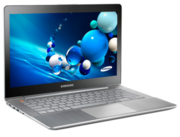
Specifications
Memory
4096 MB
, PC3-12800 DDR3 SDRAM
Display
13.xxx inch 16:9, 1920 x 1080 pixel, 10-point, capacitive, CMN1343 N133HSE-EA1, glossy: aye
Mainboard
Intel HM76 (Panther Point)
Storage
Liteonit LMT-128M6M, 128 GB
, mSATA 128 GB
Soundcard
Intel Panther Bespeak PCH - Loftier Definition Audio Controller
Connections
2 USB 2.0, 1 USB 3.0 / 3.1 Gen1, 1 VGA, 1 HDMI, Sound Connections: Headphone/Mic combo, Card Reader: 3- in-ane (SD/SDHC/SDXC)
Networking
Realtek RTL8168/8111 Gigabit-LAN (x/100/1000MBit/s), Intel Centrino Avant-garde-N 6235 (a/b/k/n = Wi-Fi 4), Bluetooth 4.0
Size
height ten width x depth (in mm): 18.8 ten 324 ten 224 ( = 0.74 x 12.76 ten 8.82 in)
Battery
57 Wh Lithium-Polymer, 3780 mAh, Battery runtime (according to manufacturer): 6.7 h
Operating Organization
Microsoft Windows 8 64 Scrap
Additional features
Speakers: JBL Stereo Speakers (2W x 2), Keyboard: Chiclet, Keyboard Low-cal: yes
Weight
1.582 kg ( = 55.viii oz / iii.49 pounds), Power Supply: 260 g ( = ix.17 oz / 0.57 pounds)
Similar devices from a different Manufacturer
Devices from a dissimilar Manufacturer and/or with a different CPU
- Tips for ownership a notebook - notebookCHECK Purchase Advisory
- Find the right notebook - notebookCHECK Hardware Guide
- Display resolution comparison - DPI (grain size) of displays
- Our test criteria
- Manufacturer'due south data
Pros | |
| + | Attractive chassis |
| + | Very good 1080p touchscreen display |
| + | All-metal construction |
| + | Piece of cake to expand (both RAM and mSATA SSD) |
| + | Good bombardment life |
Cons | |
| - | Comparatively small 128 GB SSD |
| - | Fairly heavy |
| - | No updated processor available |
| - | Keyboard lacks feedback |
Samsung 740U3E-A01UB - 2013-eleven-06 11/06/2013 v3(former)
Bernie Pechlaner
Subnotebook - Weighted Boilerplate
Bernie Pechlaner, 2013-11- 8 (Update: 2013-11-17)
Source: https://www.notebookcheck.net/Review-Samsung-ATIV-Book-7-740U3E-A01UB-Ultrabook.105031.0.html
Posted by: chanandnig.blogspot.com

0 Response to "Samsung Series 7 Ultra Touch 740u3e"
Post a Comment